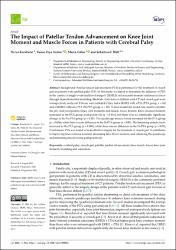| dc.contributor.author | Karabulut, Derya | |
| dc.contributor.author | Arslan, Yunus Ziya | |
| dc.contributor.author | Götze, Marco | |
| dc.contributor.author | Wolf, Sebastian | |
| dc.date.accessioned | 2022-01-11T10:28:50Z | |
| dc.date.available | 2022-01-11T10:28:50Z | |
| dc.date.issued | 2021 | en_US |
| dc.identifier.citation | Karabulut, D., Arslan, Y. Z., Götze, M., & Wolf, S. I. (2021). The Impact of Patellar Tendon Advancement on Knee Joint Moment and Muscle Forces in Patients with Cerebral Palsy. Life, 11(9), 944. | en_US |
| dc.identifier.issn | 2075-1729 | |
| dc.identifier.uri | https://hdl.handle.net/20.500.12846/627 | |
| dc.description.abstract | Background: Patellar tendon advancement (PTA) is performed for the treatment of crouch gait in patients with cerebral palsy (CP). In this study, we aimed to determine the influence of PTA in the context of single-event multilevel surgery (SEMLS) on knee joint moment and muscle forces through musculoskeletal modeling; Methods: Gait data of children with CP and crouch gait were retrospectively analyzed. Patients were included if they had a SEMLS with a PTA (PTA group, n = 18) and a SEMLS without a PTA (NoPTA group, n = 18). A musculoskeletal model was used to calculate the pre- and postoperative knee joint moments and muscle forces; Results: Knee extensor moment increased in the PTA group postoperatively (p = 0.016), but there was no statistically significant change in the NoPTA group (p > 0.05). The quadriceps muscle forces increased for the PTA group (p = 0.034), while there was no difference in the NoPTA group (p > 0.05). The hamstring muscle forces increased in the PTA group (p = 0.039), while there was no difference in the NoPTA group (p > 0.05); Conclusions: PTA was found to be an effective surgery for the treatment of crouch gait. It contributes to improving knee extensor moment, decreasing knee flexor moment, and enhancing the quadriceps and hamstring muscle forces postoperatively. | en_US |
| dc.language.iso | eng | en_US |
| dc.publisher | MDPI-Multidisciplinary Digital Publishing Institute | en_US |
| dc.relation.isversionof | 10.3390/life11090944 | en_US |
| dc.rights | info:eu-repo/semantics/openAccess | en_US |
| dc.subject | Cerebral Palsy | en_US |
| dc.subject | Crouch Gait | en_US |
| dc.subject | Patellar Tendon Advancement | en_US |
| dc.subject | Knee Muscle Forces | en_US |
| dc.subject | Knee Joint Moment | en_US |
| dc.subject | Modeling and Simulation | en_US |
| dc.subject | Serebral Palsi | en_US |
| dc.subject | Çömelme Yürüyüşü | en_US |
| dc.subject | Patellar Tendon Gelişimi | en_US |
| dc.subject | Diz Kas Kuvvetleri | en_US |
| dc.subject | Diz Eklemi Momenti | en_US |
| dc.subject | Modelleme ve Simülasyon | en_US |
| dc.subject | Zerebralparese | en_US |
| dc.subject | Hocke Gang | en_US |
| dc.subject | Patellasehnenfortschritt | en_US |
| dc.subject | Kniemuskelkräfte | en_US |
| dc.subject | Kniegelenkmoment | en_US |
| dc.subject | Modellierung und Simulation | en_US |
| dc.title | The impact of patellar tendon advancement on knee joint moment and muscle forces in patients with cerebral palsy | en_US |
| dc.type | article | en_US |
| dc.relation.journal | Life | en_US |
| dc.contributor.authorID | 0000-0002-1861-9368 | en_US |
| dc.identifier.volume | 11 | en_US |
| dc.identifier.issue | 9 | en_US |
| dc.relation.publicationcategory | Makale - Uluslararası Hakemli Dergi - Kurum Öğretim Elemanı | en_US |
| dc.contributor.department | TAÜ, Fen Bilimleri Enstitüsü, İmalat Teknolojisi Ana Bilim Dalı Koleksiyonu | en_US |
| dc.contributor.institutionauthor | Arslan, Yunus Ziya | |
| dc.identifier.wosquality | Q2 | en_US |
| dc.identifier.scopusquality | Q2 | en_US |
| dc.identifier.wos | WOS:000699678600001 | en_US |

















